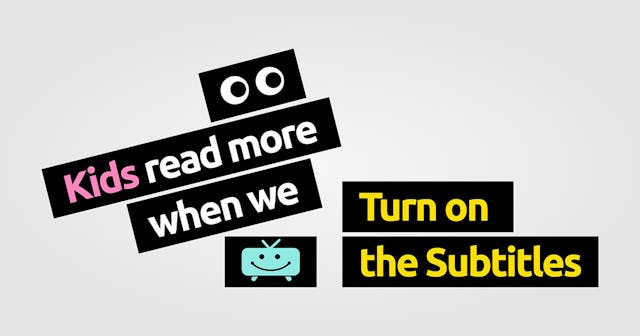Want To Help Your Kids Become Better Readers? Turn On The Subtitles

The next time someone makes you feel guilty for letting your little watch TV, show ‘em this
Mamas have it hard. There’s c-section shaming, formula shaming, snack food shaming, and yes, TV shaming. While all mom-shaming is ridiculous and needs to stop, its great to have an honest-to-goodness real-life study you can fall back on.
Turns out, in order to feel less guilty about our kiddos watching TV, we can #turnonthesubtitles. A new organization called…well… Turn On The Subtitles, is here to help your kiddos learn and make you feel less guilty about screen time. The group maintains switching on the subtitles while kids are watching tv can double the odds of a child becoming good at reading, the initiative claims.
Same Language Subtitling (SLS) is the concept of subtitling (or captioning) audio-visual material in the ‘same’ language as the outgoing audio. As the video plays, viewers connect the dialogue word for word, so what you hear is what’s written on the screen in perfect synchronicity.
It’s one of those head-slapping ‘why didn’t I think of it’ moments. Of course, turning on the subtitles will help kiddos. Giving kids something to read that they will find interesting is key to growing life-long reading habits. A comprehensive international review shows in “an academic study of 2,350 children, 34% became good readers with schooling alone. But when exposed to 30 minutes a week of subtitled film songs, that proportion more than doubled to 70%.”
Stephen Fry has been tapped to talk about the project.
The organization says the biggest push for subtitles on television has been in India, but the positive impact of using subtitles as a way to boost literacy has also been confirmed ‘in several English and non-English speaking countries’. Turn On The Subtitles says that as a whole, these studies demonstrate that exposure to captions which match the sound directly can contribute to reading advancement and learning language.
The idea has been gaining interest.
The new program stresses the key to the literacy gains is in showing content that is compelling to the viewer. Turn On The Subtitle’s website quotes MIT’s John Gabrieli, a researcher who works in the field of cognitive neurosciences. Gabrieli explains how emotion and reason “propel learning very powerfully.” SLS of audio-visual material that is appealing to kids pushes a constant flow of associations in the brain that has already figured out the correlation of language and letter-sound correspondence.
“As someone working in Deaf Education, I absolutely love this plea from the wonderful @stephenfry about the benefit and importance of using subtitles,” a Twitter user posted. “#TurnOnTheSubtitles”
Worried that your kiddo won’t watch new shows with subtitles? That’s ok. The concept works even better with things your little one has seen over and over again. The research shows that in the case of often watched media, subtitles add an extra advantage of predictable text. Your kiddo knows what’s coming, and the text on the screen bolsters that knowledge.
The organization has asked parents and teachers to spread the word by sharing the message with others. Their hope is that by turning on the subtitles, television time can naturally become reading time too.